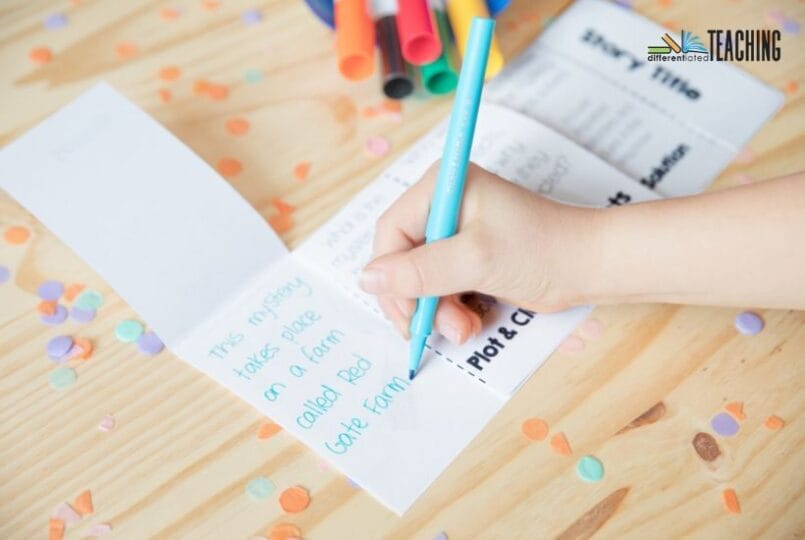Tired of ‘It Was Good’? Try These 3 Creative Book Report Alternatives
If you’ve ever wrapped up reading time, looked at your eager learner (or whole class), and asked, “So, what did you think of the book?” … Only to be met with a shrug and a half-hearted “It was good,” you’re not alone.
Whether you’re in a classroom or homeschooling at the kitchen table, helping students meaningfully respond to reading is one of those challenges that sounds simple… until it isn’t.
You want something more than a fill-in-the-blank worksheet.
You want evidence that they understood the story.
You want writing that feels reflective, not like pulling teeth.
But you also need it to be low prep, flexible across books and levels, and…Let’s be honest, not a project that takes two weeks to grade.
This is where a fresh approach to book reports can make all the difference.
In today’s post, I’m sharing three creative, classroom-tested ways to make book response time more meaningful, more manageable, and maybe even… fun. Yes, fun.
Let’s dive in.
1. Use Genre-Specific Prompts to Deepen Comprehension
One-size-fits-all book reports tend to fall flat. Why? Because not all books are built the same.
A biography calls for a different kind of reflection than a mystery. A tall tale has different structures and conventions than a realistic fiction story. When we give students genre-aligned prompts, we help them focus on the specific features of what they’ve read, and that leads to stronger comprehension.
For example, instead of just asking “What happened in the story?” you might ask:
- For a fairy tale: “How does this story show the battle between good and evil?”
- For historical fiction: “How do you know the story is set in a real time period?”
- For a myth: “What real-world phenomenon does this story try to explain?”
These prompts naturally deepen understanding without requiring more effort from you as the teacher or parent. They invite students to analyze, reflect, and connect genre elements in a way that helps them become stronger readers.
2. Foldable Flipbooks = Quick Projects That Still Show Thinking
Let’s face it: long book projects are rarely sustainable on a regular basis. Between grading, classroom time, and varying student abilities, you need something that can be done in a class period or two, but still shows real comprehension.
That’s where foldable-style book reports come in.
These print-and-go templates create a visual, hands-on way for students to reflect on their reading. Each “flap” gives a clear prompt, guiding them to write about characters, setting, genre features, or key facts (for nonfiction). The format supports reluctant writers by breaking the task into chunks, and let’s be honest—it’s just more engaging than a plain sheet of paper.
Whether you’re working with a group of fourth graders reading different books or a homeschooler diving into nonfiction animal texts, this format gives you structure without stress.
3. Swap Whole-Class Projects for Flexible Templates
Whole-class novel units have their place, but when every student is reading something different, whether it’s part of your independent reading routine, book club rotation, or homeschool book basket, you need a system that adapts.
That’s why I love using flexible, genre-based book report templates as independent reading check-ins.
Students can complete them as they finish books, you can assign specific genres during a study unit, or they can choose their own based on interest. It’s a great way to gather insights on reading comprehension without needing to front-load a specific title or prepare a custom assignment.

Plus, it allows for easy differentiation. Struggling reader finishing a short biography? High-flyer wrapping up Percy Jackson? Both can complete a flipbook that’s appropriate and rigorous… No need for three different rubrics or projects.
Free Book Report Template to Try
Want to test it out? I’ve pulled one of my most popular biography flipbook templates for you to try for free!
This foldable-style mini report is perfect for helping students organize key information about a historical figure in a way that’s structured, easy to follow, and actually fun to complete. They’ll reflect on who the person was, why they mattered, and how their story connects to the world today.
Whether you’re using it for Black History Month, Women’s History Month, or just as part of your nonfiction reading routine, this freebie makes biography writing more accessible and meaningful.
Ready for the Full Set?
If this is the kind of reading response activity that makes your teacher heart breathe a little easier, I’ve got good news. The full set of foldable book report templates includes 20 fiction and nonfiction designs—covering everything from fairy tales and tall tales to biographies, science texts, and country reports.
They’re perfect for students in grades 2–4, and they work with any book, so you can use them again and again, no matter what your readers are exploring.
???? Grab the complete Book Report Templates for Grades 2–4 here
Final Thoughts
You don’t need to reinvent the wheel to make reading response meaningful. Sometimes it’s just about shifting the format and giving students the right prompt at the right time.
Whether you’re trying to support reluctant readers, build comprehension across genres, or just get away from the dreaded “It was good,” these strategies can help make book reports work better for everyone.









